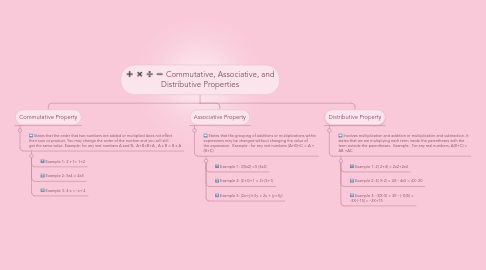Commutative, Associative, and Distributive Properties
von ARIELLE REYNOLDS


1. Commutative Property
1.1. States that the order that two numbers are added or multiplied does not effect their sum or product. You may change the order of the number and you will still get the same value. Example: for any real numbers A and B; A+B=B+A , A x B = B x A
1.1.1. Example 1: 2 +1= 1+2
1.1.2. Example 2: 5x4 = 4x5
1.1.3. Example 3: 4-x = -x+ 4
2. Associative Property
2.1. States that the grouping of additions or multiplications within expressions may be changed without changing the value of the expression. Example : for any real numbers (A+B)+C = A + (B+C)
2.1.1. Example 1: 3(5x2) =5 (3x2)
2.1.2. Example 2: (2+3)+1 = 2+(3+1)
2.1.3. Example 3: (2x+y)+3y = 2x + (y+3y)
3. Distributive Property
3.1. Involves multiplication and addition or multiplication and subtraction. It states that we are multiplying each term inside the parentheses with the term outside the parentheses. Example: For any real numbers; A(B+C) = AB +AC
3.1.1. Example 1: 2( 2+4) = 2x2+2x4
3.1.2. Example 2: 4( X-2) = 4X - 4x5 = 4X- 20
3.1.3. Example 3: -3(X-5) = 3X - (-3)(5) = -3X-(-15) = -3X+15
